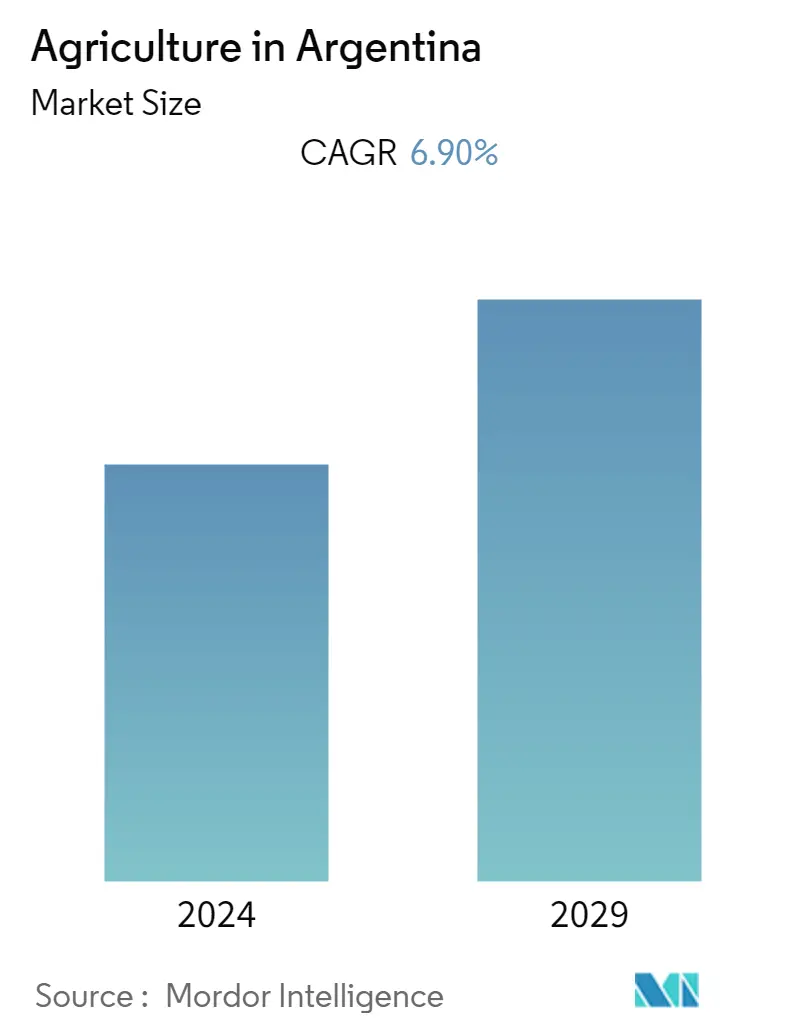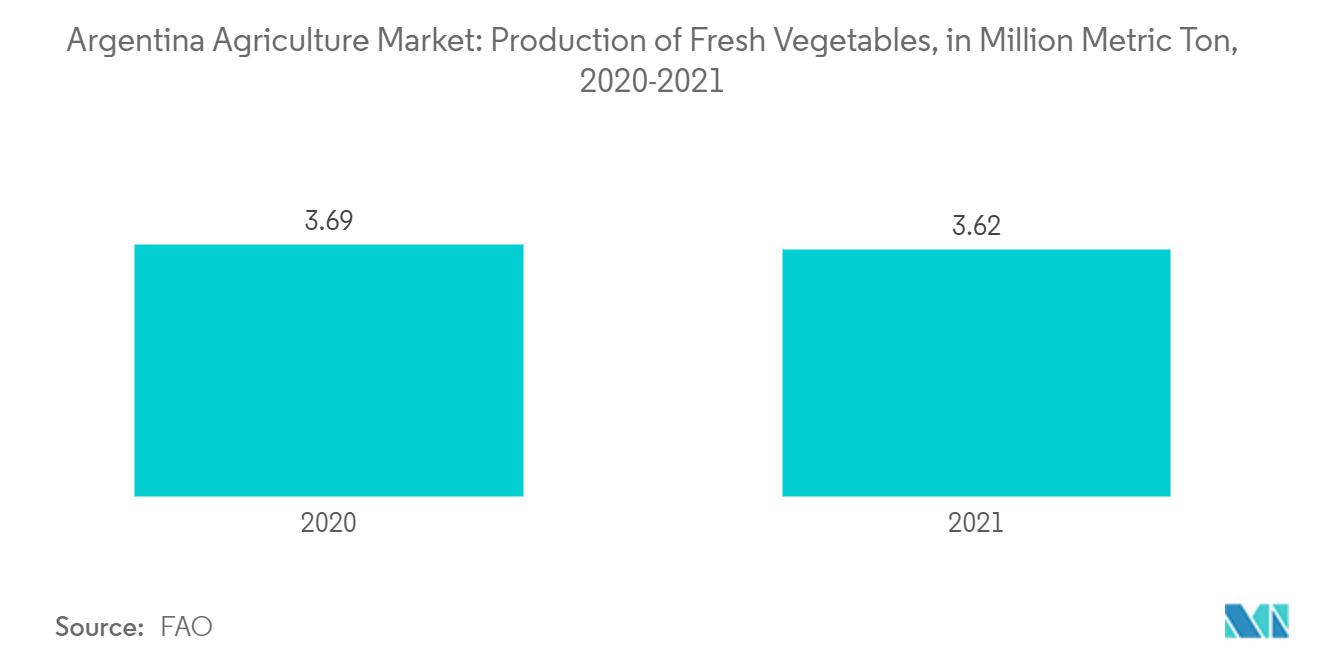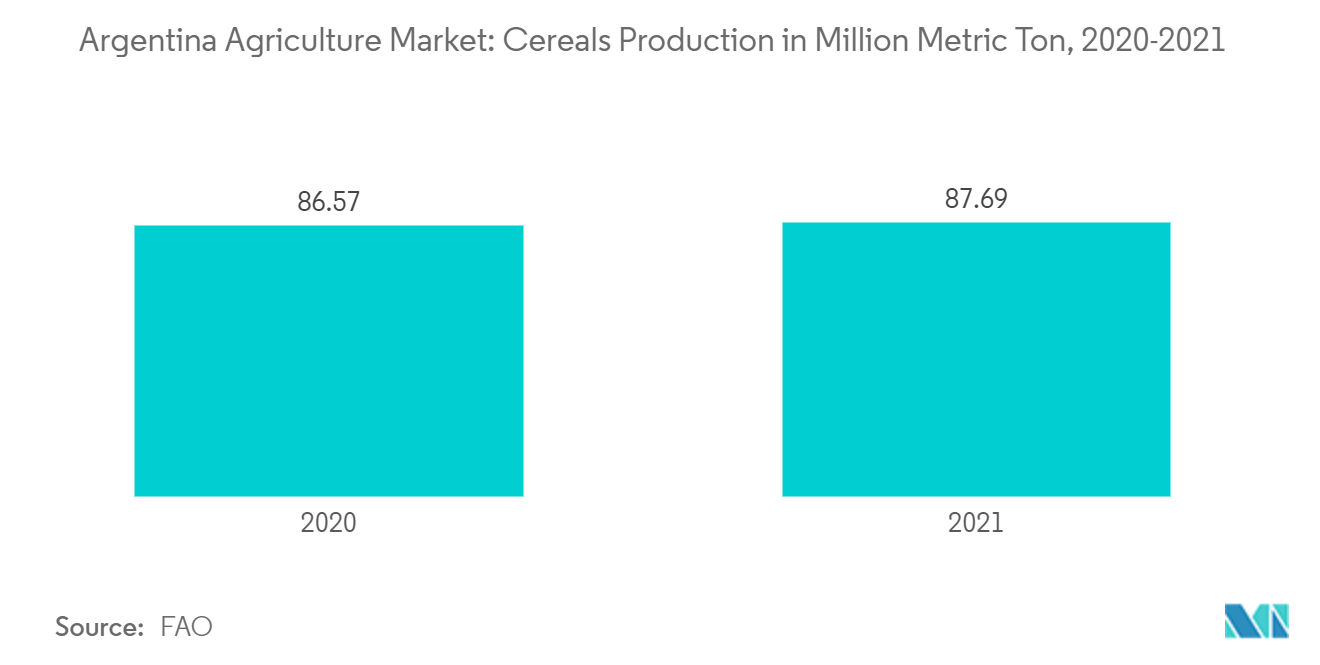Argentina Agricultural Market Size

| Study Period | 2019 - 2029 |
| Base Year For Estimation | 2023 |
| Forecast Data Period | 2024 - 2029 |
| Historical Data Period | 2019 - 2022 |
| CAGR | 6.90 % |
Major Players*Disclaimer: Major Players sorted in no particular order |
Argentina Agricultural Market Analysis
The Argentina agriculture market is projected to register a CAGR of 6.9% during the forecast period.
- The cereals and grains are leading in agricultural production followed by oilseeds, cash crops, fruits, and vegetables. Argentina consists of a wheat crop of 21.8 million ton in 2021-22 followed by 19 million ton in 2019-20, which is a 21.9% higher national wheat average yield than the previous year. However, Argentina accounted supply and distribution of oilseeds to be 50.17 million metric ton followed by India and other countries.
- Argentina is a foremost producer of fruits and vegetables such as grapes, bananas, apples, limes and lemons, pears, and onions, garlic, potatoes, tomatoes. The domestic consumption of fresh oranges significantly increased to 10.3 million metric ton in 2021 due to high supply availability and projected demand during a pandemic.
- In 2021, The World Bank approved a USD 400 million loan to implement climate-smart, innovative practices to boost the productivity and competitiveness of agri-food system and green development through investments in climate-resilient infrastructure in Argentina. Finally, the project will seek to support institutional strengthening processes in the National Agricultural Technology Institute (INTA) to promote its leadership in innovation and climate resilience in the agri-food sector.
- Increasing adoption of genetically-modified seeds in Argentina's agriculture market leads to high crop production, thereby boost high adoption of loan facilities among small and marginal farmers and investments in export & import scenario. The high growth potential of agricultural exports is driving the growth of the market and Coffee and soy-based crops play a key role in the country's agriculture market which will drive the market during the coming years.
Argentina Agricultural Market Trends
Rising Health Awareness has boosted the Demand for Fruits & Vegetables
The increasing concern of health consciousness trend is leading to more consumption of fruits and vegetables, including high import of off-season varieties in the market. There are some major fruits and vegetables such as carrots, peppers, onions, chilies, beans, turnips, tomatoes, oranges, grapes, apples, peaches, avocados, and strawberries, are characterized by high market growth potentials in Argentina during the coming years. According to FAO, the fresh vegetable segments have slightly increased with 3.62 million metric ton which is a slight decline compared to the previous year with 3.69 due to the pandemic effect in the country. After this market will going to raise at a higher pace during the forecasting period.
Rising organic food demand in order to minimize chances of chronic diseases like cancer, hypertension, and diabetes among the population is anticipated to drive the Argentina agriculture market during the forecast period. Government agencies are implementing several agricultural policies and services to promote economical and infrastructural developments in the country. For instance, the National Institute of Agricultural Technology (INTA) provides technical assistance for innovation in value chains, agricultural R&D, and extension services for small-scale producers.
The Government of Argentina announced adjustments to export taxes on many specialty crops, including apples, pears, citrus fruits, blueberries, tomatoes, broccoli, cauliflower, nuts, and alfalfa intended to improve the international competitiveness and standardize export tax rates for many products at 0%, 3%, 4.5%, and 9% to avoid varying export tax rates among similar products to encourage exports of added-value products and products whose increased production will result in higher levels of employment, and for which increasing exports won't raise food costs. The government also hopes to encourage investment in these same sectors to encourage the domestic production and demand from the consumer related to health will drive the market during the forecast period.
The rapid adoption of new technologies such as, crop rotation, precision farming, new improved seeds with genetically-modified traits, and no-tillage farming is leading to an innovative farming practices by many large service providers to increase crop productivity in the forecast period.

Cereals and Grains is Leading Agriculture Market in Argentina
The high degree of adoption of crop diversification by the producers in cereals and grains is subsequently a key driver to manage risks and soil sustainability. Furthermore, the cereals like wheat, sorghum, corn, and barley comprise a higher degree of carbon fixation in the soil, thereby a high quantity of grasses with more vegetative coverage thus leads to reduce soil and wind erosion and provides resistance to biotic and abiotic stress. According to FAO, cereals production has increased by 87.69 million metric ton in 2021 which is a slightly increased compared to the previous year and raise the market in coming years.
Argentina is the primary South American producer and exporter of wheat, accounting for about 7% of global exports. Brazil is a prominent importer, mainly from Argentina (75%), followed by the United States (10%), and 15% from Paraguay, Russia, Uruguay, and Canada. The ongoing conflict in Ukraine has caused wheat supply and food security concerns for many major wheat importers that depend on Black Sea supplies. In this case, South American producers may increase supply to African countries. Argentina already has increased exports to Africa.
Additionally, Argentina is researching on genetically engineered new wheat known as HB4 which can uses a gene taken from sunflowers. If successful, Argentina could keep its position as one of the world's top wheat exporters and might ease some agricultural concerns for the future which will drive the growth of the market in coming years. Right now, for example, China and countries in North America and Europe are at lower than usual levels of wheat production because of drought. Russia's war in Ukraine has also reduced the world's wheat supply.
The rise in silos areas for cereals and grains is also a key driver to enhancing quality of logistics services and minimizes post-harvest losses. Additionally, the silos minimizes risk of macroeconomic instability and shortage in credit among the farmers, thereby supports storage and transportation of the produce will raise the growth of the market in coming years.

Argentina Agricultural Market News
- December 2022: Argentina harvested a record 21.8 million metric ton of wheat in 2022 which was the highest compared to the last year. The country is a key wheat supplier to many countries, primarily to neighboring Brazil. However, with global supplies seen drying up from Russia, the US, and Canada, consuming countries in the Middle East are also looking at Argentina to meet their requirements.
- September 2022: The government of Argentina and IICA have long-standing joint experience in South-South cooperation projects to support Central American and Caribbean countries that are facing food security problems and are particularly vulnerable to natural disasters, which in recent years have increased in frequency and severity due to climate change.
Argentina Agricultural Market Report - Table of Contents
1. INTRODUCTION
- 1.1 Study Assumptions & Market Definition
- 1.2 Scope of the Study
2. RESEARCH METHODOLOGY
3. EXECUTIVE SUMMARY
4. MARKET DYNAMICS
- 4.1 Market Overview
- 4.2 Market Drivers
- 4.3 Market Restraints
- 4.4 Value Chain Analysis
5. MARKET SEGMENTATION
-
5.1 Cereals & Grains
- 5.1.1 Production Analysis
- 5.1.2 Consumption Analysis
- 5.1.3 Import Analysis by Volume and Value
- 5.1.4 Export Analysis by Volume and Value
- 5.1.5 Price Trend Analysis
-
5.2 Oilseeds
- 5.2.1 Production Analysis
- 5.2.2 Consumption Analysis
- 5.2.3 Import Analysis by Volume and Value
- 5.2.4 Export Analysis by Volume and Value
- 5.2.5 Price Trend Analysis
-
5.3 Fruits
- 5.3.1 Production Analysis
- 5.3.2 Consumption Analysis
- 5.3.3 Import Analysis by Volume and Value
- 5.3.4 Export Analysis by Volume and Value
- 5.3.5 Price Trend Analysis
-
5.4 Vegetables
- 5.4.1 Production Analysis
- 5.4.2 Consumption Analysis
- 5.4.3 Import Analysis by Volume and Value
- 5.4.4 Export Analysis by Volume and Value
- 5.4.5 Price Trend Analysis
-
5.5 Cash crops
- 5.5.1 Production Analysis
- 5.5.2 Consumption Analysis
- 5.5.3 Import Analysis by Volume and Value
- 5.5.4 Export Analysis by Volume and Value
- 5.5.5 Price Trend Analysis
-
5.6 Turf and Ornamentals
- 5.6.1 Production Analysis
- 5.6.2 Consumption Analysis
- 5.6.3 Import Analysis by Volume and Value
- 5.6.4 Export Analysis by Volume and Value
- 5.6.5 Price Trend Analysis
6. MARKET OPPORTUNITIES AND FUTURE TRENDS
** Subject To AvailablityArgentina Agricultural Industry Segmentation
Agriculture is the art and science of cultivating the soil, growing crops and raising livestock. The scope does not include agriculture products processed in any form, such as frozen, freeze-dried, cooked, or canned food. The Argentina Agriculture Market is Segmented by Type (Cereals & Grains, Oilseeds, Fruits, Vegetables, Cash crops, and Turf and Ornamentals). The report includes Production Analysis (Volume), Consumption Analysis (Value and Volume), Export Analysis (Value and Volume), Import Analysis (Value and Volume), and Price Trend Analysis. The report offers market size and forecasts in terms of both value (USD million) and volume (metric ton) for all the above segments.
| Cereals & Grains | Production Analysis |
| Consumption Analysis | |
| Import Analysis by Volume and Value | |
| Export Analysis by Volume and Value | |
| Price Trend Analysis | |
| Oilseeds | Production Analysis |
| Consumption Analysis | |
| Import Analysis by Volume and Value | |
| Export Analysis by Volume and Value | |
| Price Trend Analysis | |
| Fruits | Production Analysis |
| Consumption Analysis | |
| Import Analysis by Volume and Value | |
| Export Analysis by Volume and Value | |
| Price Trend Analysis | |
| Vegetables | Production Analysis |
| Consumption Analysis | |
| Import Analysis by Volume and Value | |
| Export Analysis by Volume and Value | |
| Price Trend Analysis | |
| Cash crops | Production Analysis |
| Consumption Analysis | |
| Import Analysis by Volume and Value | |
| Export Analysis by Volume and Value | |
| Price Trend Analysis | |
| Turf and Ornamentals | Production Analysis |
| Consumption Analysis | |
| Import Analysis by Volume and Value | |
| Export Analysis by Volume and Value | |
| Price Trend Analysis |
Argentina Agricultural Market Research FAQs
What is the current Agriculture in Argentina Market size?
The Agriculture in Argentina Market is projected to register a CAGR of 6.90% during the forecast period (2024-2029)
What years does this Agriculture in Argentina Market cover?
The report covers the Agriculture in Argentina Market historical market size for years: 2019, 2020, 2021, 2022 and 2023. The report also forecasts the Agriculture in Argentina Market size for years: 2024, 2025, 2026, 2027, 2028 and 2029.
Agriculture in Argentina Industry Report
Statistics for the 2024 Agriculture in Argentina market share, size and revenue growth rate, created by Mordor Intelligence™ Industry Reports. Agriculture in Argentina analysis includes a market forecast outlook to 2029 and historical overview. Get a sample of this industry analysis as a free report PDF download.



